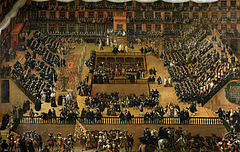Francisco Rizi
| ||
 Auto-da-fé na Placu Mayor w Madrycie (1683) | ||
| Data i miejsce urodzenia | 1614 Madryt, Hiszpania | |
| Data i miejsce śmierci | 1685 Escorial, Hiszpania | |
| Narodowość | hiszpańska | |
| Dziedzina sztuki | malarstwo | |
| Epoka | barok | |
Francisco Rizi (ur. w 1614 w Madrycie, zm. w 1685 w Escorialu) – hiszpański malarz okresu baroku.
Był synem Antonia Ricciego, włoskiego artysty działającego w Hiszpanii. Urodził się i wychował w Madrycie. Był uczniem Vicente Carducha. Za panowania Filipa IV otrzymał tytuł malarza królewskiego. Malował obrazy religijne (m.in. dla klasztoru Paciencia de Cristo w Madrycie) oraz portrety. Pracował w teatrze w Pałacu Buen Retiro, gdzie odpowiadał za maszynerię techniczną i projektował dekoracje. Duże walory dokumentacyjne ma jego wielkoformatowe płótno o niezwykłej dynamice kompozycyjnej – Auto-da-fé na Placu Mayor w Madrycie (1683).
Malarzem był również jego brat Fray Juan Andrés Rizi (1600–1681), benedyktyn, autor Traktatu o mądrym malarstwie.
Wybrane dzieła
- Auto-da-fé na Placu Mayor w Madrycie – 1683, 277×438 cm, Prado, Madryt
- Chrystus z szat obnażony – 1651, Prado, Madryt
- Madonna z Dzieciątkiem i świętymi Filipem i Franciszkiem – 1665, Capuchinos, El Pardo
- Niepokalane Poczęcie – ok. 1651, 289×174 cm, Prado, Madryt
- Ofiarowanie w świątyni – ok. 1650, 206×291 cm, Prado, Madryt
- Pokłon Trzech Króli – ok. 1650, 54×57 cm, Prado, Madryt
- Portret generała artylerii – ok. 1660, 202×135 cm, Prado, Madryt
- Profanacja krzyża – 1647–1651, 207×230 cm, Prado, Madryt
- Św. Agata – ok. 1680, 184×108 cm, Prado, Madryt
- Św. Andrzej – 1646, 247×137cm, Prado, Madryt
- Zwiastowanie – ok. 1665, 112×96 cm, Prado, Madryt
Bibliografia
Media użyte na tej stronie
The work represents an auto de fe celebrated in Madrid on June 30, 1680, during the reign of Charles II of Spain. The ritual was held in the Plaza Mayor and lasted a whole day. In the background we see the royal tribune and in it Charles II, his wife María Luisa and his mother. Distinguished people from the court are located on the balconies. On the left, rich carpet and on it the altar with the green cross, symbolizing the hope of forgiveness of the reconciled, and the banner of the Holy Office. Next door, the stands of public office, and the throne of the inquisitor general who is still next to the king's tribune after taking an oath. In the center of the painting we see two prisoners dressed as in the 15th century, with coroza and sambenitos with flames, the rapporteurs or readers of causes and sentences in the pulpits, and some Dominicans with the preacher in the central pulpit. On the right are the stands for relatives of the Inquisition and prisoners in person or statue (dead or fled), which bears an inscription with their crimes and a box with their bones. Prisoners could be penance (punished with various penalties and who by abjuring their mistakes became reconciled) or relaxed (condemned to death in a club, or at the stake if they were repeat offenders). In the foreground are the soldiers of faith and donkeys who will take those condemned to death on the outskirts of the city to be executed by secular justice. In this group of soldiers at the bottom center of the painting, we find a male figure who carries a large drum widely used in this type of ceremony.
